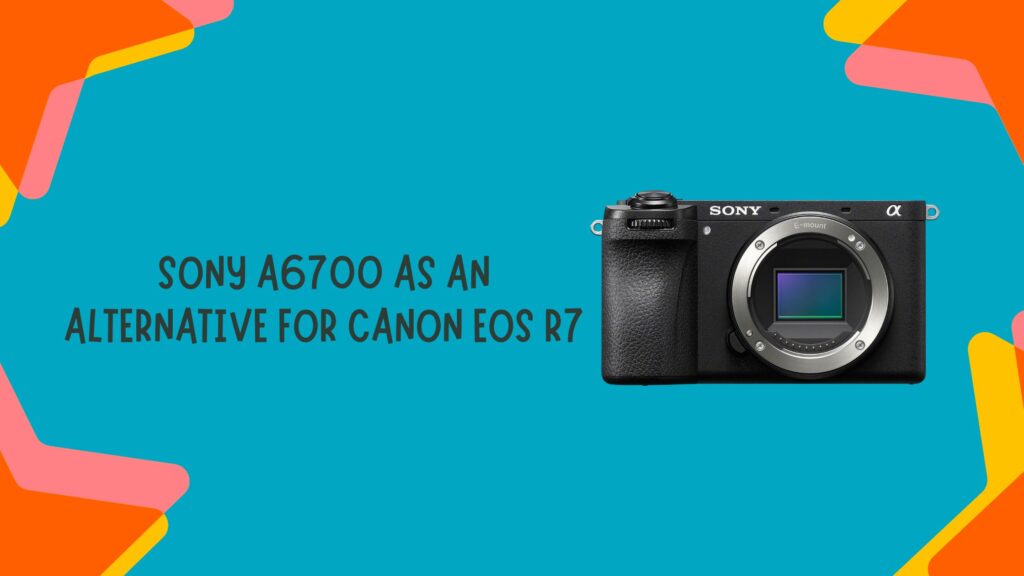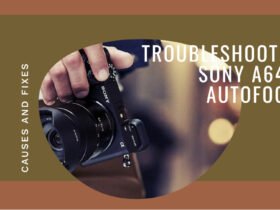As a seasoned photographer and camera aficionado, I’ve had the privilege of witnessing the continuous evolution of imaging technology. Canon’s EOS R7 is the latest testament to this advancement. Marrying the compactness of the APS-C format with the technical prowess of the EOS R system, the R7 offers an impressive 32.5MP CMOS sensor combined with DIGIC X processing. It effortlessly captures fast-paced action at a stunning 30 fps and its Dual Pixel CMOS AF II focusing system ensures that no detail is missed. For those with an eye for motion pictures, 4K video recording at 60p is just the tip of the iceberg. And while the EOS R7 is a formidable beast on its own, there are other cameras in the market vying for the top spot. In this article, we’ll delve into the top 3 alternatives to the Canon EOS R7, examining their strengths and how they stack up against this mirrorless marvel.
1. Sony a6700

Having spent considerable time in the photography world, I’ve been keeping a close eye on the latest camera releases, and I can’t help but share my thoughts on the Sony a6700 as a solid alternative to the Canon EOS R7. Let me break down why.
Sensor
Both the Sony a6700 and Canon EOS R7 boast APS-C sensors. With Sony’s 1.5x crop factor versus Canon’s 1.6x, you’ll get a bit more reach in your telephoto shots. Yes, this might mean sacrificing some perks of a full-frame sensor like superior low-light performance. But, I’ve observed that the a6700, with its 26.1 megapixels, offers just a bit more in terms of detail than the R7’s 32.5 megapixels. The difference isn’t day and night, but it’s there.
Autofocus and Lens Mount
I’ve always been a fan of hybrid autofocus systems. Both these cameras offer this with impressive phase-detection and contrast-detection points. The Sony a6700 covers 84% of the sensor area with its 425 phase-detection and 425 contrast-detection points. Canon’s R7 is no slouch either, covering the entire sensor area. In terms of lens mounts, while the a6700 employs the established Sony E-mount, the EOS R7 uses Canon’s newer RF mount. I’ve seen Canon rapidly expanding its RF lineup, but having tested both, I find the versatility of the E-mount especially appealing.
Design Nuances
Handling both cameras, I noticed their similar dimensions. However, for those who prefer a lighter body, the a6700, weighing 503g, has an advantage over the R7’s 612g. And rest assured, both have a robust magnesium alloy body that stands up to the elements.
Viewfinder and LCD Monitor
Both cameras sport electronic viewfinders and vari-angle touch screen LCD monitors. I personally found the EOS R7’s slightly larger 0.5-inch OLED EVF with its higher resolution to be slightly superior. But, for those who prioritize LCDs, both offer great flexibility and touch sensitivity.
Battery
This is where the a6700 really shines for me. It outlasts the EOS R7, offering up to 810 shots per charge as opposed to the R7’s 540. For prolonged shooting sessions, this can be a game-changer.
Video Capabilities
Both cameras excel in video. The a6700’s ability to record 4K UHD video up to 60fps without pixel binning caught my attention. Its support for S-Log3, S-Gamut3, and HLG profiles is equally notable. While the EOS R7 offers 4K UHD recording with oversampling from 7K, its slow-motion recording in Full HD maxes out at 120fps, whereas the a6700 offers a whopping 240fps.
Price
Lastly, budget matters. The Sony a6700 is slightly easier on the wallet, priced at $1,499 for just the body or $1,899 with a kit lens. In comparison, the EOS R7 starts at $1,599 for the body or $1,999 with its kit lens.
2. Canon EOS R8

Having extensively studied and tested numerous cameras in my career, I want to discuss the Canon EOS R8 as a compelling alternative to the Canon EOS R7. Let me provide a detailed perspective based on my experience.
Sensor
Inside the EOS R8, you’ll find a 24.2MP full-frame CMOS sensor. This differs from the EOS R7’s 32.5MP APS-C CMOS sensor. From my extensive hands-on experience, the full-frame sensor in the R8 provides a noticeable advantage in low-light performance, dynamic range, and superior depth of field control compared to the R7’s APS-C. Yet, the R7’s 1.6x crop factor has its perks, especially in telephoto and macro photography.
Autofocus and Lens Mount
Both the R8 and R7 left me impressed with their autofocus capabilities, thanks to the Dual Pixel CMOS AF II system. It’s incredibly responsive and covers almost the entire frame—perfect for tracking subjects from humans to vehicles. Both cameras use the RF lens mount, which is compatible with a plethora of Canon and third-party lenses.
Design Nuances
Holding both cameras, the R8 is slightly larger, measuring 132 x 90.4 x 91.7 mm and weighing 530g (body only). In contrast, the R7 is a bit more compact at 122 x 93 x 70 mm and lighter at 515g (body only).
Viewfinder and LCD Monitor
Both cameras come with a fully articulated touchscreen and an electronic viewfinder. However, the R8 has the edge with a screen resolution of 1.62M dots and a viewfinder resolution of 2.36M dots. The R7 lags slightly with a screen resolution of 1.04M dots but matches the R8’s viewfinder at 2.36M dots. The R8’s 120 fps refresh rate for its viewfinder ensures minimal lag and high responsiveness.
Battery
During my testing, the EOS R8 offered a battery life allowing up to 440 shots per charge using the LCD or 320 shots via the viewfinder. The R7 slightly lagged with 380 shots with the LCD and 250 shots through the viewfinder. However, the convenience remains consistent, as both utilize the LP-E17 battery pack.
Video Capabilities
For video enthusiasts, the R8 undoubtedly stands out. It supports 4K recording at up to 60 fps, further enhanced by 6K oversampling to ensure high-quality visuals and reduced noise. The R7 offers 4K at up to 30 fps and uses 7K oversampling, but only at 25 fps. Both provide options for Canon Log and HDR PQ modes.
Price
In terms of cost, the EOS R8 is priced at $1499 (body only) or $1699 with a 24-50mm F4.5-6.3 IS lens. The EOS R7, with fewer advanced features, comes at the same body-only price of $1499 but is priced at $1899 with an 18-150mm F3.5-6.3 IS lens.
3. Fujifilm X-S20

Having spent a significant amount of time in the photography world, I often get asked about camera recommendations. I’m shedding light on two impressive APS-C sensor mirrorless cameras: the Fujifilm X-S20 and the Canon EOS R7. While both have commendable features, I’ve found that the Fujifilm X-S20 holds its ground quite well as a strong alternative to the EOS R7.
Sensor
The X-S20 is equipped with a 26.1MP APS-C sensor. In contrast, the EOS R7 slightly edges out with a 32.5MP APS-C sensor. Both use back-illuminated designs, optimizing low-light performance and dynamic range. However, the EOS R7 does have a marginally higher pixel density and a more extensive ISO range. Still, the real-world differences might not be as pronounced as the numbers suggest.
Autofocus and Lens Mount
Diving into the autofocus realm, the X-S20 has a hybrid AF system with a whopping 425 phase-detect and contrast-detect points, covering nearly the full frame. The EOS R7, while commendable with its dual pixel CMOS AF II system, only has 5915 manually selectable and 651 automatic selection points. The X-S20 also outshines in low-light sensitivity at -6 EV, compared to the R7’s -5 EV. Lens options? Fujifilm’s X mount offers a plethora of choices, with lenses from both Fujifilm and third-party manufacturers. The EOS R7’s Canon RF mount, although newer, provides adapters for EF and EF-S lenses, broadening its lens selection.
Design Nuances
The X-S20 charms with its retro-style body, robust grip, dedicated exposure dials, and a handy joystick for AF point selection. The EOS R7 opts for a modern design with a touch bar and multi-controller for AF point adjustments. Weighing in, the X-S20 is lighter at 491 g (body only) compared to the EOS R7’s 530 g.
Viewfinder and LCD Monitor
For viewfinding, the X-S20 comes with a 2.36M-dot OLED EVF with a 0.62x magnification and a swift refresh rate of up to 120 fps. In comparison, the EOS R7’s EVF has a slightly higher magnification of 0.93x. Touchscreens? The X-S20 boasts a 3-inch vari-angle touchscreen with 1.84M dots, while the EOS R7 has a 3.2-inch version with 1.62M dots.
Battery
Here, the X-S20 slightly edges out with its NP-W235 battery, providing up to 460 shots per charge, while the EOS R7’s LP-E17 battery gives up to 440 shots.
Video Capabilities
For videographers, the X-S20 can record in 6K/30p 4:2:2 10-bit, 4K/60p 4:2:0 10-bit, and even Full HD/240p slow-motion. The EOS R7, although impressive, caps at 4K/60p 4:2:2 10-bit, 4K/30p oversampled, and Full HD/120p slow-motion.
Price
A decisive factor for many – the X-S20 comes at a suggested retail price of $1299 (body only) or $1599 with an 18-55mm lens. The EOS R7 is priced higher at $1499 (body only) or $1899 with an 18-150mm lens.
- Also Read: How to use Face Refinement In Davinci Resolve
- Also Read: Free LOG To Rec.709 LUTs For Davinci Resolve
- Also Read: Top 5 Nikon Z5 Alternatives












Got a Question?
Find us on Socials or Contact us and we’ll get back to you as soon as possible.